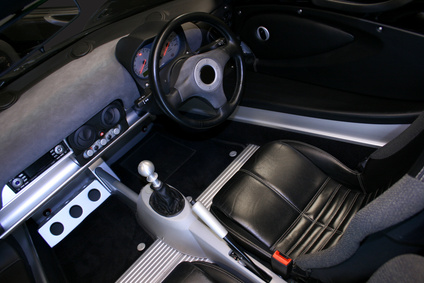
Your vehicle's radio has a hard enough time staying tuned to the correct frequency because of all the electromagnetic pulses and transmissions from the environment around us. Distance from the transmission station, weather and obstacles in nature, and man-made structures all can contribute to radio distortion and poor reception. These conditions exist and we have to live with them. When the reception problem comes from the vehicle, the vehicle owner will have to find out what's causing it and how to eliminate it. Radio static can arise from several locations and components. The vehicle owner can check the most likely causes, and with diligence, solve the problem.
Disconnect the negative battery cable from its post. Locate the positive (red) power wire that connects to the back of your radio. For pull-out radios, you will have to find the wire on the other side of the electrical connection block. Use a pair of wire strippers to snip the wire a few inches back from the radio. Splice in a capacitor (noise suppression filter) onto the wire, using electrical connectors. Tape the connection for added protection. When finished, reattach the battery cable.
Examine the antenna mount. For metal telescoping or whip antennas on your Ford, use a Phillips screwdriver or small socket to firmly tighten the screws or bolts. Some antennas have large ring nuts, which will require tightening with a large end wrench. This will ensure a tight ground.
Seek out a good quality set of resistor-type plug wires at your local auto parts store. These plugs wires have been designed to suppress high voltage ignition interference. With the engine off and negative battery cable disconnected, install the wires one at a time, unhooking them from the distributor cap and the spark plug tip. Start the engine when finished and note any noticeable change in the reception.
Open the hood of your Ford. Disconnect both battery cables at the battery posts. Clean both cable ends with a battery cleaning tool, as well as the battery posts. Reconnect and tighten them. Disconnect the negative battery wire where it grounds against the frame. Clean the frame and the cable eyelet with a wire brush, and then reconnect it, tightening it firmly. Look for any other braided ground straps that connect the engine to the frame. Disconnect them with the proper socket and clean both sides of the connection points with a wire brush. Reconnect and tighten them firmly.
Remove the distributor cap and look at the electrodes on the inside. Look for black (burned) hairline cracks originating from the electrode and extending into the plastic surface. Electrodes that have burned or arced across poles will cause static interference. Check the top of the rotor for burn and arc marks. Replace the cap or rotor if such damage exists.
Run the Ford engine at night with the hood up, or park the vehicle in an enclosed garage with minimum light. Examine all of the plug wires at their connections where they fasten to the distributor and the spark plug. Look for any bright blue arcing from the wires to the engine block or manifolds. Cracked wires or loose connections will allow pulses of electricity to escape and cause radio static. Look at the high voltage coil wire and its connection points. Make sure no arcs exist along the wire or at its boot locations. Look at the back of the alternator where the main battery wire is connected. No external electrical arcing should come from the alternator. Tighten and clean any and all connections.